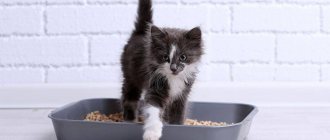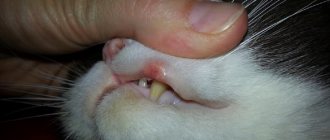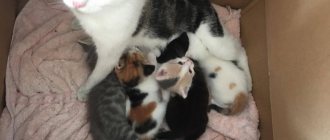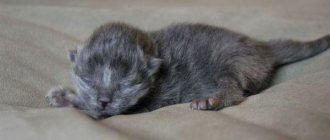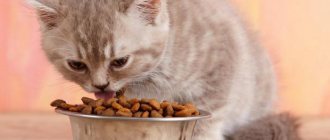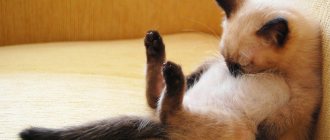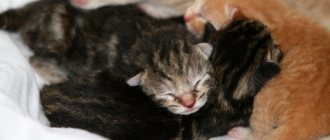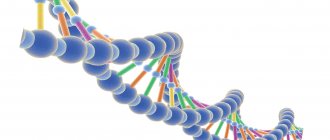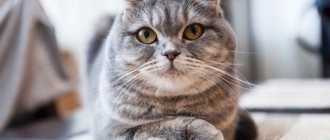Among the many metabolic pathologies, rickets in domestic animals occupies one of the leading places. The disease is typical for young animals. The disease affects not only the skeletal system and affects the growth and development of the body. In addition to an imbalance of mineral elements, the disease is accompanied by an imbalance of proteins, lipids, microelements, and vitamins. Rickets is a systemic pathology that negatively affects all organs and physiological functions of growing young animals.
Causes of development in cats
The main factors provoking the development of rickets in young domestic cats, according to experienced breeders and veterinary specialists, are the following:
- Unbalanced diet of the mother cat during pregnancy. The absence or deficiency of essential amino acids in the diet, in particular taurine, leads to disruption of embryo development.
Deficiency of protein and other nutritional components adversely affects the development of the skeletal system of fetuses during intrauterine development. The situation is aggravated by a lack of vitamin D and E and ascorbic acid in the diet. A deficiency of mineral elements, in particular calcium, phosphorus, magnesium, leads to underdevelopment of the future kitten's skeleton.
- Violation of animal breeding rules. Mating more than once a year weakens the cat’s body, which is a common cause of the birth of sick offspring. Experts include incorrect selection of parent pairs into this group of factors, especially among representatives of large breeds. The risk of developing rickets and other diseases increases when related pairs interbreed.
Allowing an exhausted or obese animal to breed is also one of the common reasons for the birth of weakened young animals. Early onset of the first pregnancy in an immature female increases the risk of developing rickets in newborn kittens.
- Failure to comply with sanitary and hygienic rules when raising offspring. High humidity, poor ventilation, and lack of sunlight slow down metabolic processes in a growing body. Without the ultraviolet spectrum of daylight, vitamin D obtained from mother's milk is not converted into an active form and is not absorbed by the kittens' body.
- Diseases of the gastrointestinal tract of various etiologies (non-contagious, infectious, parasitic causes). Inflammatory processes in the intestines are accompanied by impaired absorption of nutrients, including vitamins and microelements.
- Artificial feeding. The use of milk substitutes does not meet the physiological needs of newborn kittens, causing metabolic disorders.
- An unbalanced diet and violation of feeding rules when switching to independent nutrition. A sharp refusal of mother's milk and the beginning of feeding on adult food is fraught not only with the development of intestinal problems, but also with metabolic disorders in the body of a growing kitten.
- Lack of vitamin and mineral supplements in the diet of young animals with natural feeding.
We recommend reading about vitamin deficiency in cats. You will learn about the causes and manifestations of vitamin deficiency, the dangers of hypovitaminosis, and preventive measures. And here is more information about what to feed a pregnant cat.
Disease prevention
In fact, preventing this pathology is as easy as shelling pears.
It is important to feed newborn animals plenty of breast milk. It is important to properly maintain your pets and feed them adequately, periodically introducing special vitamins into the diet. It is important to give pets the opportunity to move - be it cats or dogs, to go for a walk, and to be in the sun for as long as possible in the summer.
Cats and dogs must be vaccinated against the most common infectious diseases. Periodically give vitamin complexes with omega-3 fatty acids. If a kitten/puppy is left without a mother, then along with feeding, give them calcium-containing products internally, unless, of course, this is a special mixture for newborns. Be sure to start introducing adult food from 2-2.5 months, giving more meat products. As prescribed by a specialist, you can take fish oil for prevention.
It is important to give pets the opportunity to move - be it cats or dogs, to go for a walk, and to be in the sun for as long as possible in the summer. Cats and dogs must be vaccinated against the most common infectious diseases
Periodically give vitamin complexes with omega-3 fatty acids. If a kitten/puppy is left without a mother, then along with feeding, give them calcium-containing products internally, unless, of course, this is a special mixture for newborns. Be sure to start introducing adult food from 2-2.5 months, giving more meat products. As prescribed by a specialist, you can take fish oil for prevention.
Animals at risk
Rickets is primarily susceptible to young domestic cats aged from birth to six months. The risk group includes kittens born on the street from
stray cats.
When adopting a foundling, the future owner must be aware of the risk of developing pathologies of the musculoskeletal system in such pets in the near future.
There is a high probability of metabolic disorders with rachitic manifestations in artificially fed kittens. The use of cow's milk and infant formula for these purposes leads to an imbalance of protein components, mineral elements and vitamins in a growing body.
Most often, kittens born in the spring are susceptible to rickets. This is due to a deficiency of sunlight, as well as vitamins in the diet of the mother cat and young animals.
What is rickets?
Rickets is one of the chronic diseases. It is associated with a violation of the quality of bone formation and the entire skeleton. The mineral volume in this disease is significantly impaired, and this affects many other systems and the overall development of the kitten. If there is not enough calcium in the diet, if there is little vitamin D and phosphorus, then rickets will be a clear signal of these deficiencies. If the cat did not eat properly during pregnancy, did not receive the necessary support or even multivitamin complexes, the appearance of rickets in a large number of kittens cannot be called a miracle. If in the first months of life you did not care for the kittens well enough, then rickets can form, because kittens grow very quickly and they need daily support.
Symptoms of disease development
Taking into account the negative impact of rickets at an early age on the growth and development of the animal, the owner should seek veterinary help as soon as possible if signs of the disease are detected in a small kitten. The following symptoms should alert you:
- A newborn has a weak sucking reflex from the first days. The baby moves little and cannot find his mother's nipple on his own.
- Thin. Compared to its brothers and sisters from the same litter, the sick kitten looks emaciated, does not gain weight, and is developmentally delayed.
- Disproportional development of the body. Upon visual inspection, the owner notes that the belly is too large (inflated) and poorly developed limbs.
- When palpating the chest, thickenings are felt on the ribs, the so-called rachitic “rosary”.
- On the limbs, when palpated, you can notice similar thickenings in the form of bracelets - formations at the ends of tubular bones.
- An unsteady, shaky gait develops due to weakness of the musculoskeletal system.
- In the later stages of the disease, muscle cramps are observed.
- The change of teeth occurs with delay and delay.
- Young animals have a sagging back.
- Disturbance of digestive processes in the form of dyspepsia, chronic constipation. An imbalance of minerals leads to a malfunction of the liver and pancreas, which provokes a deficiency of digestive enzymes.
- Increased appetite against the backdrop of continued exhaustion of the animal.
- Decreased motor activity, lethargy, apathy.
- Shortness of breath, heart failure.
In the later stages of pathology development, sick kittens may experience spontaneous fractures associated with fragility of bone structures. Animals are noticeably lagging behind in growth and development, do not meet breed standards, and are in poor physical shape.
In advanced cases, the pet develops anemia and heart failure. Curvature of the chest leads to disruption of the functioning of internal organs, including the lungs and heart. The fragility of bone structures leads to fractures and serious pathologies of the hip joint.
The consequences of rickets are convulsions and nervous attacks. The animal loses the ability to move normally. Vitamin and mineral imbalance leads to disruption of protein metabolism, which adversely affects the function of all organs and systems. The consequence of rickets is most often disability.
To see what a cat with rickets looks like, watch this video:
Signs of rickets in kittens
The first changes begin in the first months of a kitten’s life, so in most cases, owners immediately notice the symptoms of the disease. One of the very first signs is the absence of a sucking reflex.
With rickets, the pet moves little, it cannot find the cat’s nipple, and it looks emaciated (in comparison with other kittens). He lags behind in general development and gains weight very slowly. Visually, he has a very large belly and underdeveloped paws.
Other signs indicating the development of rickets in kittens:
- shaky and unsteady gait,
- visually noticeable sagging (curvature) of the spine,
- frequent retching and vomiting, belching and other dyspeptic disorders,
- diarrhea or, conversely, chronic constipation,
- lethargic state
- apathy,
- little activity
- slow change of teeth,
- muscle cramps (characteristic of the last stages of the disease).
If your kitten shows signs of rickets, then do not hesitate - contact a veterinary clinic in Moscow. It is important not to neglect the disease, since without accurate diagnosis and treatment it can lead to dangerous consequences, including death.
Diagnostic methods
At the slightest sign of retardation in the growth of young animals, the owner should contact a veterinarian. It is not worth fighting metabolic pathologies on your own, since the consequences of rickets for the animal are very serious.
In a veterinary facility, the kitten will first have its blood drawn for biochemical testing. Low levels of minerals such as calcium and phosphorus suggest the development of rickets. An increase in the concentration of alkaline phosphatase and a disturbance in the blood clotting system may also indirectly indicate a violation of mineral metabolism.
An effective way to diagnose rickets is x-ray examination. The method makes it possible to detect rarefaction of bone tissue, curvature of tubular bones characteristic of rickets, and deformation of the chest and spine.
X-ray of a cat's spine with rickets
Differential diagnosis is carried out primarily in relation to hyperparathyroidism based on the blood picture and x-rays. When the parathyroid gland is diseased, it is not the bone tissue that suffers, but the muscles and kidneys. If necessary, the animal is prescribed an electrocardiogram of the heart and an ultrasound examination of the internal organs.
Causes of rickets
In veterinary clinical medicine, a number of specific factors are subdivided that are fundamental for the development of rickets in cats. Professional breeders and veterinary specialists agree that the main provoking factor is an imbalance in the cat's diet during pregnancy.
A small amount of amino acids, of which taurine is the main one, leads to improper development of fruits. The development of kittens in the womb is adversely affected by disturbances in metabolic processes that cause a pronounced lack of protein components, as well as fat-soluble vitamin E and ergocalciferol.
The development of rickets in young animals can also be affected by degenerative processes associated with insufficient intake of ascorbic acid into the body or if its absorption is impaired. The underdevelopment of the skeletal system of small kittens is based on a deficiency of calcium, phosphorus and magnesium. Other factors that provoke the development of rickets include:
- Incorrect breeding processes. Too frequent mating of a cat greatly depletes the mother's body, and as a result leads to the birth of sick kittens or non-viable offspring. Professional breeders claim that the selection of pairs of cats plays an important role in breeding. Closely related pairs of cats run the risk of giving birth to kittens with rickets. It is not recommended to breed emaciated and weakened animals, as well as cats with increased body weight, which leads to the risk of developing pathologies of metabolic processes.
- Early mating in females with an incompletely formed reproductive system. The onset of the first pregnancy in a female that is not sexually mature increases the risk of developing rickets in newborn kittens.
- Violation of the rules for keeping cats and kittens. High humidity and insufficient ventilation in a living room negatively affect metabolic processes in young organisms. Violations of sanitary and hygienic standards also include a lack of sunlight. Without sufficient exposure to ultraviolet rays on the skin, the amount of absorbable vitamin D and calcium in the body of a small kitten, obtained through mother's milk, decreases, leading to the development of rickets.
- Diseases of the digestive tract. All kinds of infectious and non-invasive pathologies of the stomach and intestines of an inflammatory nature disrupt the normal absorption of vitamin and mineral complexes.
- Replacement of mother's milk. Using artificial complementary foods instead of cat milk provokes metabolic disorders. Especially if complementary foods are not of high quality and do not contain the necessary mineral and vitamin supplements.
- Malnutrition when a kitten transitions from mother's milk to adult food. A sharp transition from mother's milk to adult food can lead not only to problems with the digestive tract, but also cause metabolic disorders. When switching a kitten to adult and solid food, owners often forget about important mineral supplements in the diet.
Treatment of rickets
Therapeutic measures for metabolic diseases are long-term in nature and require the owner to scrupulously follow all the appointments and instructions of a veterinary specialist.
In the hospital
First of all, treatment of rickets is aimed at eliminating the deficiency of minerals and vitamins.
For this purpose, the animal is prescribed intravenous injections of calcium preparations. The most commonly used are calcium gluconate or calcium chloride. In a specialized clinic, in addition to infusion therapy, physiotherapy is used, in particular, therapeutic quartz lamps.
At home
After eliminating the acute deficiency of minerals in the body of a sick kitten, treatment can be continued at home. Vitamin therapy is of no small importance in curing rickets. In particular, without vitamin D, calcium and phosphorus cannot be absorbed into the blood. For these purposes, fish oil is used - a rich source of vitamins A and D, omega acids.
Vitamin D (ergocaciferol) can also be used independently in the form of an oil preparation. The dose is selected by the attending physician. Ascorbic acid, B vitamins, tetravit are prescribed to the animal in the form of intramuscular injections.
Vitamin therapy for rickets
If necessary, medications are used for a sick pet to maintain heart function: camphor, cardamine, and magnesium preparations. In case of severe dyspeptic symptoms, the veterinarian prescribes enzyme preparations that envelop decoctions.
A therapeutic diet is an essential component in the treatment of metabolic diseases. The therapist will recommend special premium and super-premium food, rich in complete protein, calcium, phosphorus, and vitamins. When feeding your pet natural food, the diet should be based on beef, chicken and fish.
Lactic acid products (low-fat cottage cheese, kefir, cream) are an excellent source of calcium. To provide the body with vitamins, vegetables are introduced into the diet. With a natural type of nutrition, vitamin and mineral supplements are mandatory.
In addition to drug therapy and a therapeutic diet, physiotherapy must be used in the treatment of rickets. At home, a sick pet should be given sunbathing. It is best to do this in the morning, from 9 to 11 am. Under the influence of ultraviolet radiation, metabolic processes in the subcutaneous tissue are activated, and the body's absorption of vitamins and minerals improves.
It is useful to give sick kittens a therapeutic massage. A veterinarian will show you the technique of the procedure. Massage improves blood circulation and tissue trophism.
The owner of a sick animal should pay special attention to the physical activity of the pet. Physical activity promotes better absorption of minerals and vitamins obtained from food and administered intravenously or intramuscularly. For this purpose, the kitten should purchase a gaming complex and interesting toys. Walking in the fresh air will be useful.
After rickets in childhood
If the animal had rickets at a young age, then even with successful treatment it is necessary to regularly undergo a therapeutic course, which is prescribed on the basis of a biochemical blood test. As a rule, the pet is given a course of treatment with vitamin and mineral preparations and chondroprotectors.
We recommend reading about anemia in cats. You will learn about the causes of this pathology, symptoms and complications for your pet, diagnosis and treatment, prevention, and feeding rules. And here is more information about how to help a cat with a dislocation.
Treatment
As soon as the owner notices symptoms of rickets in his pet, he should immediately go to a veterinarian. After treatment is prescribed, procedures must begin immediately. Any delay can aggravate the situation.
The purpose of the complex treatment required for rickets is to compensate for the lack of required substances in the kitten’s body. If the disease is at an early stage, then a positive outcome of complete recovery is highly likely.
First aid
Treatment of rickets in a kitten begins first of all with normalizing the presence of necessary substances in the body. For this purpose, droppers with calcium chloride or gluconate are prescribed. A solution of vitamin D is injected subcutaneously, and tetravit is prescribed orally - 10 drops.
After this, after a few days, the kittens are given fish oil capsules and added to their food. Additionally, vitamins B, A, and C may be prescribed by injection.
Basic treatment
It takes a lot of time to treat a kitten with rickets. The main treatment begins with the normalization of living conditions. Namely:
- providing a dry and bright living space with the possibility of prolonged exposure to natural daylight;
- the room should be ventilated regularly;
- provide the opportunity to walk in sunlight, and use an ultraviolet lamp in winter;
- increase the animal's physical activity through games and walks.
Your veterinarian will help you plan a diet, which is a very important part of your kitten's recovery.
- It is mandatory to introduce fermented milk products into the diet in the form of calcined cottage cheese, which is easily prepared using fresh milk and calcium chloride.
- Ensuring that food contains sufficient meat, fish, cereals, and egg yolks.
- Natural food can be replaced with ready-made food, specially designed for such cases. At the same time, mix natural food with ready-made industrial feed.
To restore the functions of internal organs after an illness, the following measures are introduced:
- You can restore the digestive system by using enzymes (pancreatin, mezim) with a gradual reduction in dosage. Taking and stopping medications should be carried out under the supervision of specialists. The liver will help restore galstena or karsil. Decoctions with an enveloping effect are beneficial for the stomach. For example, a decoction of flax seeds.
- To restore the impaired contractile function of the heart muscle, adonizide is suitable; blood supply will improve the prestranium.
- Chondroitin and glucosain are often prescribed for joints.
- Bionormalizer and trimetazidine will help speed up metabolism.
Severe damage to the cat’s body will require support for the cardiovascular system, for which purpose the kitten is given infusions of magnesium-containing drugs and cordiamine with camphor.
Prevention and exclusion
To prevent the development of rickets in young animals, a responsible breeder must follow the following breeding rules:
- Carefully select parent pairs for mating.
- Do not allow sick, emaciated or obese animals to be bred.
- Receive offspring from a cat no more than twice every three years.
- During pregnancy, feed the cat only high-quality premium and super-premium food intended for pregnant animals.
- A cat in an interesting position benefits from sunbathing and fresh air.
- When artificially feeding or supplementing newborns, you should use only special formulas intended for kittens.
- Compliance with sanitary standards when raising young animals (availability of ventilation, temperature conditions, sunlight).
- Transfer to independent feeding should be carried out no earlier than 2 - 2.5 months. In this case, the food must be of high quality and appropriate for the pet’s age.
- Timely vaccination against infectious diseases and treatment of young animals against helminths.
Rickets in kittens is a common disease associated with a deficiency of vitamin D, as well as calcium and phosphorus in the body. The cause of the disease is most often an error in feeding the pregnant female. Due to the fact that the disease can lead to disability of the animal, the owner should not hesitate to visit a veterinarian.
Treatment includes the use of medications, a special diet, and physical therapy. The role of preventive measures aimed at preventing deficiency of vitamins and minerals is great.
Prevention of rickets
Prevention of rickets is much better than its treatment (which does not guarantee a positive outcome). To do this, you need to follow a number of not too complicated rules:
- A cat should be bred no more than twice a year. It’s even better if within a year and a half the pet had no more than two matings that ended in pregnancy. Consult with a specialist when choosing the most balanced diets. If your cat has gastrointestinal or kidney diseases, mating should not be allowed.
- Kittens should be picked up no earlier than ten weeks, but no later than 12 weeks.
- If possible, take walks with your pet more often.
- Provide “self-employment” for the animal. Buy more toys, let your pet play more, as movement is vital for him.
- Vaccinate your cat on time and take him to the veterinarian at least once a quarter for a preventive examination.
- Give your cat one fish oil capsule every couple of months. The course of preventive treatment is exactly one week. It is also permissible to include one drop of Tetravit in the diet (in the absence of fish oil capsules) during the same period.
Useful video
To learn how to massage a cat with rickets, watch this video:
Similar articles
- Dislocation in a cat of the hip joint, anterior or...
For example, with a bruise or injury to the occipital bone in a cat, a dislocation occurs... destruction of joint and bone tissue (rickets, osteoporosis, osteomalacia). Read more - Types of worms in animals
Dogs and cats can become infected with Toxocara by eating infested... Infected animals experience: • stunted growth, may have rickets • stomach... Read more
- Vitamin deficiency in a cat: symptoms, how it manifests itself...
How does vitamin deficiency manifest itself in a cat? Pathology develops most often in... Young animals develop rickets due to a violation of phosphorus-calcium... Read more
- Anemia in cats: symptoms, types (infectious...)
What causes and how to treat anemia in cats. Blood diseases are common among domestic cats. Read more
- What to feed a pregnant cat: how to choose food...
How dangerous is toxoplasmosis in cats for animals and people? ... Vitamin deficiency leads to underdevelopment and rickets in kittens, to curvature of the spine in adults... Read more
Diagnostics
A qualified doctor will never diagnose “rickets” by eye, especially at the initial stage of the disease. Therefore, the patient undergoes a comprehensive examination. When collecting anamnesis, the doctor analyzes the following data:
- rationality of the way of eating;
- conditions of detention;
- conditions of development in the mother's womb.
The main attention is paid to the results of laboratory tests:
- blood testing to determine the content of phosphorus, calcium, vitamin D;
- radiography of the bone;
- histological examination of bone tissue.
The differential diagnosis should exclude articular rheumatism, osteomalacia, and parathyroid dysfunction.
Prevention
As preventive measures against rickets in kittens, veterinary experts recommend the following:
- With the help of specialists, select the most optimally balanced diet for both a pregnant or lactating cat, and for kittens during the period of active growth.
- Provide your pet with timely vaccinations and the use of antihelminthic medications.
- After consulting with your veterinarian, you can take vitamin D and fish oil for preventive purposes.
- Properly plan the mating of a cat. In 12 months, no more than two births with good nutrition. You cannot breed weakened, infected, sick animals, and it is also not recommended to breed cats that are too obese or underweight.
- Painless weaning of a kitten from its mother – at least 2.5 months. It is better not to purchase an animal before this period, since breastfeeding must be complete.
- Cats, like dogs, need walks in the fresh air. If this is not possible, then the cat should be provided with exposure to the sun using open windows or a loggia.
Home prevention also includes therapeutic massages that improve blood circulation. At the same time, the kitten is given an active lifestyle through periodic walks and games.
Even in the case of timely diagnosis and proper treatment, an animal that has recovered from rickets will need close attention from its owners to its health status for life. Regular visits to the veterinary clinic for periodic examinations every 6 months will be necessary for life. There you will have to donate blood for biochemical analysis. Periodic vitamin therapy will not hurt either.
Only a responsible attitude of owners towards the health of their pets and their needs can make the life together of a person and an animal full and happy.
We invite you to familiarize yourself with the Maintenance of a dachshund in a house and apartment. How to care for a dog?
Symptoms of the disease
Typically, a breeder identifies rickets in a small kitten by the following signs:
- significant lag in growth and development compared to other kittens in the litter;
- lack of communication with his fellows, prefers to sit unnoticed in the corner;
- conditioned reactions are usually slowed down;
- the back of the animal sags, and the belly increases significantly;
- the spine and legs are noticeably curved;
- the gait is unsteady and uncertain, sometimes with a noticeable limp;
- no change of teeth is observed;
- joints are usually increased in size;
- the ribs are flattened.
Sometimes the animal develops diarrhea, muscle spasms, shortness of breath and a severe cough. These are secondary signs indicating the development of this pathology.
Description of the disease
The disease does not cause significant discomfort for a young animal.
But if rickets in a kitten is not diagnosed and not treated on time, then the resulting changes in the body cannot be eliminated. In an adult animal, rickets does not develop. Rickets in cats after a year is observed only as visible consequences of a disease suffered in the cat's childhood.
Disruption of metabolic processes leads to a deficiency of calcium and phosphorus, which negatively affects the condition of the teeth, claws and skeletal system. Rickets in kittens leads to curvature and abnormal development of the animal's skeleton.
The leaching of calcium, which is a building material for bones and teeth, leads to softening. First of all, the joints and periosteum are affected, which is why the kitten’s growth slows down. Deforming processes in softened bones cause the skeleton to bend under the weight of the body.
Lack of calcium slows down protein synthesis. Because of this, the composition of bile changes, and serious disturbances in liver function are observed. Digestive processes are disrupted, which means the absorption mechanism of fats, minerals and vitamins is greatly deteriorated. And a lack of microelements in the body leads to endless constipation or diarrhea.
The same reason leads to a decrease in the fat layer and a sharp weight loss of the animal. An insufficient amount of calcium immediately affects the ability of the heart muscle to contract.
Rachitis: features and consequences
Rickets, or hypovitaminosis D, is a pathology (demineralization) of bone tissue. It occurs due to a critical lack of vitamin D in the body, a regulator of calcium and phosphorus metabolism necessary for bone growth.
In the first six months of life, meowing cubs undergo active bone formation. Therefore, a lack of vitamin D is especially dangerous. Its acute deficiency is fraught with the development of rickets in kittens. The main symptom of the disease—violation of ossification—is far from the only one.
A chronic and systemic disease develops over several weeks and results in a complex of complications:
- anemia;
- exhaustion;
- bronchopneumonia;
- catarrhal gastroenteritis;
- myocardial dystrophy;
- umbilical and scrotal hernias;
- decreased resistance to infections.
The presence of a “bouquet” of deviations causes growth retardation and developmental delays. Doctors classify such patients as hypotrophic; in everyday life they are called “little ones.” A sick animal really looks unsightly: with a large head, short legs and a “frog” (saggy) belly.
We invite you to familiarize yourself with Mutant or Mossy Barb? What kind of fish is this?

